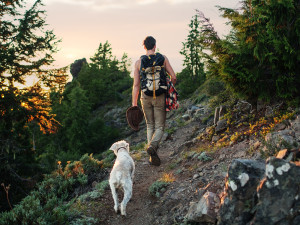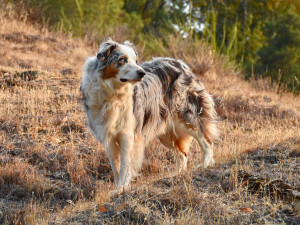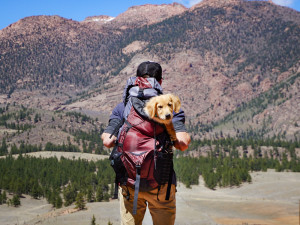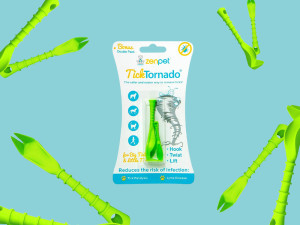How to Take Silly Little Mental Health Hikes With Your Dog
It’s good for you both — promise.

Share Article
As you stare down the last month until fall officially begins, both you and your water-obsessed dog may be getting a little melancholy. Once that chill hits, swimming, canoeing, kayaking, and all your favorite ways to splash around with your pup are gone for another few seasons. But here’s something that will perk up your dog’s sad, droopy tail: It’s hiking season!
Getting out and taking a stupid walk for your stupid mental healthopens in new tab (it’s a TikTok referenceopens in new tab — mental health is very not-stupid) will benefit both you and your dog. A few hours spent immersed in nature can cleanse the spirit and strengthen your bond with your pup. Being out in nature with your dog is truly a winning combination — and one that’s backed by science. But while you revitalize your mind and crunch around in those fall leaves, you must also be sensitive to the environment and pay attention to other trail users to preserve the tranquility of the wild lands for all.

Snap a pic of your pup’s teeth, and GREENIES™ will help you spot potential signs of oral health issues.
Outdoor expert Dan Nelson, author of the Best Hikes with Dogs series (The Mountaineers Books), shares some important tips for hiking with your dog.
Nine Tips for Hiking With Dogs
1. Use Common Sense and Courtesy
As a hiker, you are responsible for your own actions on the trail. As a pet parent, you have an additional responsibility: your dog’s actions. When you encounter other trail users, whether hikers, climbers, trail runners, bicyclists, or horse riders, the Golden Rule of Trail Etiquette is to observe common sense and simple courtesy.
How much do you spend on your pet per year?

2. Keep Your Dog on a Leash
Hikers who take their dogs on the trails should have their dogs on a leash — or under strict voice command — at all times. Strict voice command means the dog immediately heels when told, stays at heel, and refrains from barking.
3. Yield the Right-Of-Way
When pet parents meet any other trail users, you and your pup must yield the right-of-way, stepping well clear of the trail to allow the other users to pass without worrying about “getting sniffed.” This is especially important with bicyclists, runners, climbers, or horseback riders; it is easier for hikers to step off the trail than for bicyclists to lift their bikes or for horse riders to steer their horse off-trail.
4. Take Care When Meeting Horses
When meeting horses on the trail, pet parents must first yield the trail and ensure their dog stays calm, does not bark, and makes no move toward the horse. Horses can be easily spooked by strange dogs, and the pet parent is responsible for keeping their pet quiet and under firm control. Move well off the trail (downhill from the trail when possible) and stay off the trail, with your dog held close to your side until the horses pass well beyond you. Be calm, stay in clear view, and talk in a regular volume to the riders.
5. Always Stick to the Trails
Hikers and dogs should stick to the trails and practice minimum impact. Don’t cut switchbacks, take shortcuts or make new trails. If your destination is off-trail, leave the trail in as direct a manner as possible by moving away from the trail in a line perpendicular to the trail. Once well clear of the trail, adjust your route to your destination.
6. Follow All Local Ordinances
Obey the rules specific to the trail you are visiting and know that some routes are not dog-friendly. When in national parks, always follow National Park Service’s B.A.R.K initiative rules: Bag your pup’s waste, always leash your pet, respect wildlife, and know where you can go. When in doubt, double-check local trail rules before bringing your pup along.
7. Avoid Disturbing the Wildlife
Take care not to disturb wildlife, especially in winter and in calving or nesting areas. Observe wildlife from a distance — resist the urge to move close. This not only keeps you and your pup safe but also prevents the animal from having to exert itself unnecessarily while fleeing from you. Though the risk is relatively small, it’s also worth noting the potential danger of being attacked by a wild animal or contracting contagious diseases from wildlife, so it’s best to keep your distance.
8. A Pack Is Where It’s At
Pack-wearing pups can carry their own gear (think: water bowl, poop bags, etc.), and a pack makes them easier to see. Many of the folks unfamiliar with dogs on trails will be reassured of the friendliness and trail worthiness of your dog if they see them wearing a pack or reflective vest of some sort. If they have dogs, they may even ask for advice on training dogs to carry a pack; if they are non-dog people, they’ll at least smile and give your pup a quick pat.
9. Leave No Trace
When out on the trail, hikers should always ensure that they pack out what they pack in — and that includes dog poop. Carry plenty of dog poop bags. Whenever your pup needs to relieve themself, ensure that you promptly pick up their poop. Never leave poop behind to “pick up on your way back” — that’s unsightly and unpleasant for other hikers. Pick up all your personal belongings and trash and leave all natural creatures, objects, and features as you found them for others to enjoy.
These are just a few of the ways hikers with dogs can maintain a safe and harmonious trail environment. You don’t need to make these rules fit every situation; just be friendly and courteous to other people on the trail. If they have questions about your dog, try to be informative and helpful.
Pet parents must be the epitome of respectful and responsible trail users. When other hikers encounter dogs and their people behaving responsibly, they will come away with a positive experience. In this way, conscientious pet parents can prevent actions that could lead to additional trail closures or restrictions for dog hikers.
So, keep it simple: Use common sense and courtesy to avoid problems on the trail with your dog, and enjoy your healthy hikes!
This information has been adapted with permission from Dan Nelson’s Best Hikes with Dogs: Western Washington, 2nd Ed.published by The Mountaineers Books.
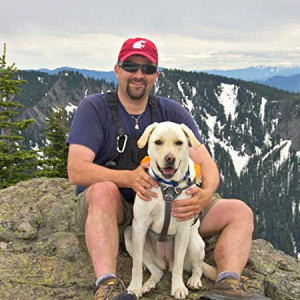
Dan Nelson
Dan Nelson is the author of several guidebooks, and creator of three best-selling national series: Snowshoe Routes series, Best Hikes with Dogs series, and Day Hiking series.
Related articles
![Man hiking with his dog in the forest at dusk]()
Hikes & Hops: 8 Great Dog-Friendly Spots in the Midwest
A hike and a craft beer? Done.
![Australian Shepherd on a hill during golden hour]()
How to Hike Safely With Your Dog This Summer
Time to get your gear—and your pup—ready to go.
![Man backpacking with his Golden Retriever puppy in a state park]()
51 Dog-Friendly US Spots to Visit With Your Pup This Summer
Where to go and what to do—from Alabama to Wyoming.
![Tick Tornado product by ZenPet on a blue background surrounding by the green tick removal tools in a dynamic design]()
Adventure Dogs Need a Tick Tornado
This teeny tweezer is more powerful than you think.




